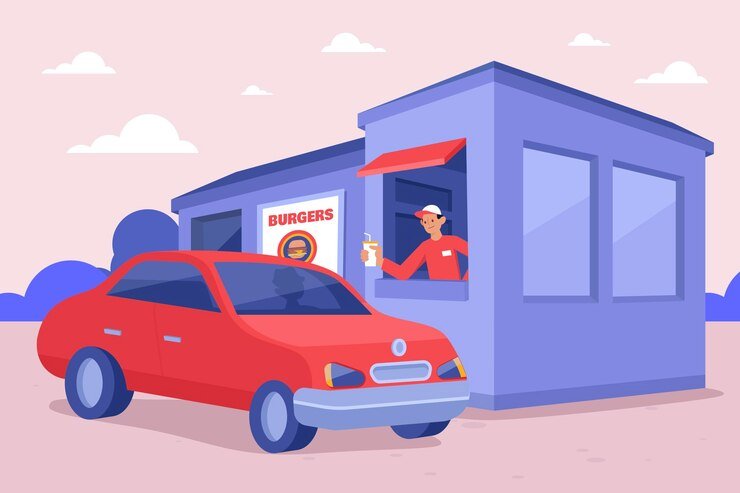Introduction
In today's fast-paced world, drive-thru systems have become an integral part of customer service, offering unparalleled convenience and efficiency. In Saudi Arabia, these systems are rapidly gaining popularity across various industries, from restaurants to pharmacies and banks. This blog explores the evolution, benefits, and implementation of drive-thru systems, focusing on their transformative impact in Saudi Arabia.
A drive-thru system allows customers to place and receive orders without leaving their vehicles. These systems are designed to streamline operations and enhance the customer experience.
Key Components of a Drive-Thru System
- Order Point: Where customers place their orders, often through an intercom.
- Payment Station: Where payments are processed.
- Pickup Window: Where customers receive their orders.
- Technology Integration: Includes POS systems, headsets, and display boards.
Benefits of Drive-Thru Systems
1. Convenience for Customers
Customers save time by avoiding the need to park and enter the establishment.
2. Increased Operational Efficiency
Streamlined workflows and reduced in-store crowding lead to faster service.
3. Higher Revenue Potential
Drive-thru lanes can handle more customers in less time, boosting sales.
4. Enhanced Safety
Drive-thru services reduce direct human contact, a key advantage during health crises like COVID-19.
The demand for drive-thru systems in Saudi Arabia has surged as businesses adapt to changing consumer preferences.
Industries Adopting Drive-Thru Systems
- Quick-Service Restaurants (QSRs): Chains like McDonald's and KFC lead the way.
- Pharmacies: Offering medication pickup through drive-thru lanes.
- Banks: Enabling customers to access financial services efficiently.
- Coffee Shops: Brands like Starbucks provide drive-thru options for busy customers.
Cultural Shift
In Saudi Arabia, the rise of drive-thru systems reflects a growing emphasis on convenience and modernity.
Implementing a Drive-Thru System
1. Site Planning
- Space Management: Ensure ample room for drive-thru lanes without disrupting regular parking.
- Traffic Flow: Design lanes to prevent congestion.
2. Technology Integration
- POS Systems: Efficient payment processing.
- Intercom Systems: Clear communication between customers and staff.
- Digital Menu Boards: Dynamic displays for promotions and menu updates.
3. Staff Training
Equip staff with the skills to manage drive-thru operations efficiently, ensuring accuracy and speed.
4. Customer Feedback
Continuously gather feedback to refine the drive-thru experience.
Drive-Thru System in Saudi Arabia: Opportunities and Challenges
Opportunities
- Market Growth: Increasing demand in urban areas.
- Innovation: Potential for AI-powered systems and mobile app integration.
Challenges
- Initial Costs: High setup and technology costs.
- Traffic Management: Ensuring smooth flow in busy areas.
Future of Drive-Thru Systems
1. Integration of AI and Automation
- AI can streamline order-taking and payment processes.
- Robots may handle food preparation in the future.
2. Mobile Integration
Apps can allow customers to place orders in advance, further reducing wait times.
3. Sustainability
Eco-friendly designs, such as solar-powered systems, are gaining traction.
Conclusion
The rise of drive-thru systems in Saudi Arabia highlights a shift towards convenience-driven customer service. By adopting modern technologies and addressing local needs, businesses can leverage drive-thru systems to enhance efficiency and customer satisfaction. As the trend continues to grow, it is poised to revolutionize the way people interact with businesses across the country.
FAQs
1. What industries benefit most from drive-thru systems?
Quick-service restaurants, pharmacies, banks, and coffee shops are the primary beneficiaries.
2. Are drive-thru systems expensive to implement?
While initial costs can be high, the long-term benefits, such as increased sales and customer satisfaction, often outweigh the investment.
3. How can businesses manage traffic in drive-thru lanes?
Effective lane design, clear signage, and staff training can help minimize congestion.
4. Can drive-thru systems be eco-friendly?
Yes, businesses can adopt solar-powered systems, energy-efficient equipment, and recyclable packaging to reduce their environmental impact.
5. What is the future of drive-thru systems in Saudi Arabia?
With advancements in AI, mobile integration, and sustainability, drive-thru systems are set to become even more efficient and widely adopted in Saudi Arabia.







